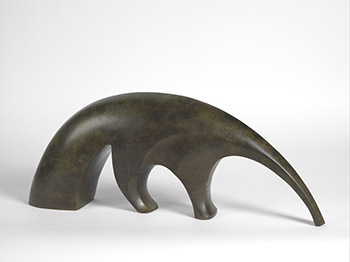PROVENANCE:
Galerie Makassar, Paris
Acquired from the above by the present owner, circa 1995
ILLUSTRATED:
Ferdinand Parpan Sculpteur , les Editions de l’Amateur, Paris, 1989, color illustrated, pp. 110-111 (another cast)
Jean-Charles Hachet, Ferdinand Parpan , L'intuition des formes, Somogy éditions d'Art, Paris, 2001, illustrated, no. 50-4, p. 105 & p. 123 (another cast)
This painting is to be sold with a certificate of authenticity signed by the artist, issued by Makassar-France; and a certificate of authenticity signed by the artist.
Catalogue Note:
LE FOURMILIER
FERDINAND PARPAN
Ferdinand Parpan is a sculptor of figur es, animals, musicians, and religious subjects. Parpan is highly praised for his simplification forms of sculptures. When Parpan was young, he learned to sculpt from his father who was a wood carver and an ornamentalist. Parpan planned to study at the École des Beaux-Arts in Paris, instead he worked as an apprenticeship mastering engraving, dry-point etching and modelling at the age of 13 due to World War I. Parpan became a well-trained profession given the solid years of apprenticeship, his works are now in the collection of Musee d'Art Moderne in Paris and Musee de Vaz-Obervaz in Switzerland.
Inspired by Egyptian art and Moder nist sculptors, such as François Pompon (1855-1933) and Constantin Brancusi (1876- 1957), Parpan began working with new materials, such as marble, ivory, agate, in addition to feature simplified forms and streamlined curves. Post World War I, Parpan undertook several public commissions to replace works that had been destroyed, he became intrigued by the aesthetics of religious art and incorporated certain aspects of this beauty in his own work. By the 1950s, Parpan was widely exhibited in Paris salons, such as the Salon des Independants, Salon d’Autome, Salon de L’Art Libre, etc. Parpan soon received universal acclaim over his refinement of forms. Parpan went on to receive international exposure after his major solo exhibition held at the Grande Galerie in 1950. He wa s honoured with the Prix d’Honneur de la Sculpture in 1965, silver medal from the Ville de Paris in 1972, and Grand Prix d’European de la Sculpture in Rouen in 1991.
Parpan has a curious mind that enjoyed the company of animals and the wilderness, having lived close to Vincenees Zoo in Paris, it was a place for him to stop by regularly. “Le Fourmilier“ is one of his finest representation of animals sculptures to be shown here. If this were an ink art painting, this could’ve been done with a few strokes, for it to be completed in forms. Yet, this particular bronze anteater was based on careful observation of its habitat and ways of living, given it vitality and warm emotions attached to it. The typical characteristics of anteaters ar e no doubt with its elongated muzzle and cylindrical snout; it has a highly sensitive sense of smell, with a tail that is long enough to withhold its entire body on the tree. Looking at the present lot, Parpan simply outline the body of the anteater with crescent shape, emphasizing its elongated muzzle against sturdy tail, precisely expressing its biological traits with its purest forms. Parpan deliberately present these animals in their original state, in turn they allowed people to look at them in br oader aspects and lear n more about them in liberated minds.
